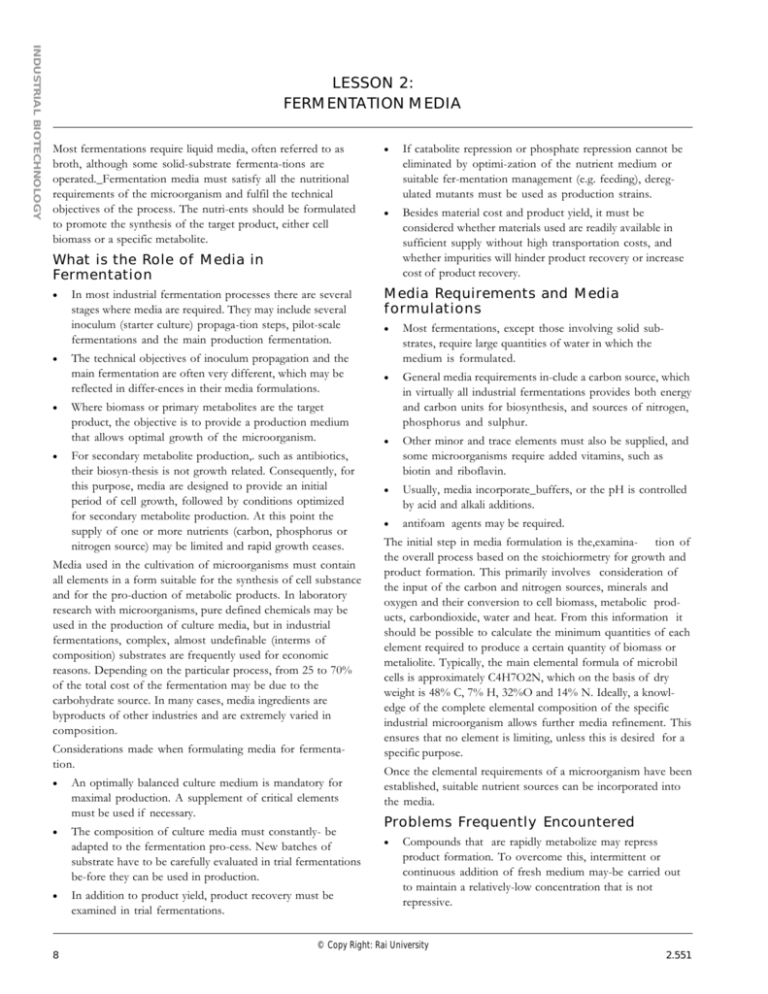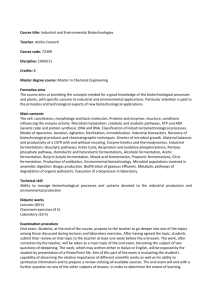LESSON 2: FERMENTATION MEDIA
advertisement

INDUSTRIAL BIOTECHNOLOGY LESSON 2: FERMENTATION MEDIA Most fermentations require liquid media, often referred to as broth, although some solid-substrate fermenta-tions are operated._Fermentation media must satisfy all the nutritional requirements of the microorganism and fulfil the technical objectives of the process. The nutri-ents should be formulated to promote the synthesis of the target product, either cell biomass or a specific metabolite. • If catabolite repression or phosphate repression cannot be eliminated by optimi-zation of the nutrient medium or suitable fer-mentation management (e.g. feeding), deregulated mutants must be used as production strains. • Besides material cost and product yield, it must be considered whether materials used are readily available in sufficient supply without high transportation costs, and whether impurities will hinder product recovery or increase cost of product recovery. What is the Role of Media in Fermentation • • In most industrial fermentation processes there are several stages where media are required. They may include several inoculum (starter culture) propaga-tion steps, pilot-scale fermentations and the main production fermentation. The technical objectives of inoculum propagation and the main fermentation are often very different, which may be reflected in differ-ences in their media formulations. • Where biomass or primary metabolites are the target product, the objective is to provide a production medium that allows optimal growth of the microorganism. • For secondary metabolite production,. such as antibiotics, their biosyn-thesis is not growth related. Consequently, for this purpose, media are designed to provide an initial period of cell growth, followed by conditions optimized for secondary metabolite production. At this point the supply of one or more nutrients (carbon, phosphorus or nitrogen source) may be limited and rapid growth ceases. Media used in the cultivation of microorganisms must contain all elements in a form suitable for the synthesis of cell substance and for the pro-duction of metabolic products. In laboratory research with microorganisms, pure defined chemicals may be used in the production of culture media, but in industrial fermentations, complex, almost undefinable (interms of composition) substrates are frequently used for economic reasons. Depending on the particular process, from 25 to 70% of the total cost of the fermentation may be due to the carbohydrate source. In many cases, media ingredients are byproducts of other industries and are extremely varied in composition. Considerations made when formulating media for fermentation. • An optimally balanced culture medium is mandatory for maximal production. A supplement of critical elements must be used if necessary. • The composition of culture media must constantly- be adapted to the fermentation pro-cess. New batches of substrate have to be carefully evaluated in trial fermentations be-fore they can be used in production. • In addition to product yield, product recovery must be examined in trial fermentations. 8 Media Requirements and Media formulations • Most fermentations, except those involving solid substrates, require large quantities of water in which the medium is formulated. • General media requirements in-clude a carbon source, which in virtually all industrial fermentations provides both energy and carbon units for biosynthesis, and sources of nitrogen, phosphorus and sulphur. • Other minor and trace elements must also be supplied, and some microorganisms require added vitamins, such as biotin and riboflavin. • Usually, media incorporate_buffers, or the pH is controlled by acid and alkali additions. • antifoam agents may be required. The initial step in media formulation is the,examina- tion of the overall process based on the stoichiormetry for growth and product formation. This primarily involves consideration of the input of the carbon and nitrogen sources, minerals and oxygen and their conversion to cell biomass, metabolic products, carbondioxide, water and heat. From this information it should be possible to calculate the minimum quantities of each element required to produce a certain quantity of biomass or metaliolite. Typically, the main elemental formula of microbil cells is approximately C4H7O2N, which on the basis of dry weight is 48% C, 7% H, 32%O and 14% N. Ideally, a knowledge of the complete elemental composition of the specific industrial microorganism allows further media refinement. This ensures that no element is limiting, unless this is desired for a specific purpose. Once the elemental requirements of a microorganism have been established, suitable nutrient sources can be incorporated into the media. Problems Frequently Encountered • Compounds that are rapidly metabolize may repress product formation. To overcome this, intermittent or continuous addition of fresh medium may-be carried out to maintain a relatively-low concentration that is not repressive. © Copy Right: Rai University 2.551 Certain media nutrients or environmental conditions may affect the physiology, biochemistry, and morphology of the microorganism. In some yeasts the single cells may develop into pseudo-mycelium or flocculate, and filamentous fungi may form pellets. This is not desirable as it affects the product yield The media adopted also depend on the scale of the fermentation. For small-scale laboratory fermentations pure chemical are often used in well defined media.However, this is not possible for most industnal-scale fermentation processes, simply due to cost, as media components may account for up to 60-80% of process expenditure. • Table 2.1: Composition of sugar beet and sugar cane molasses Composition Dry matter % Sucrose Raffinose Invert sugar Miscellaneous organic materials N P,Os CaO MgO K,O SiO, AI,O3 Fe,O3 Ash Thiamine Riboflavin Pyridoxine Niacinamide Pantothenic acid Folic acid Biotin Industrial-scale fermentations primarily use cost-effective complex substrates, where many car-bon and nitrogen sources are almost undefinable. Most are derived from natural plant and animal materials, often byproducts of other industries, with varied and variable composition. Small-scale trials are usually performed with each new batch of sub-strate, particularly to examine the impact on product yield and product recovery. The main factors that affect the final choice of indi-vidual raw materials are as follows. 1. Cost and availability: ideally, materials should be inexpensive, and of consistent quality and year round availability. 2. Ease of handling in solid or liquid forms, along with associated transport and storage costs, e.g. require-ments for temperature control. 3. Sterilization requirements and any potential denatu-ration problems. 4. Formulation, mixing, complexing and viscosity characteristics that may influence agitation, aeration and foaming during fermentation and downstream processing stages. 5. The concentration of target product attained, its rate of formation and yield per gram of substrate utilized. 6. The levels and range of impurities, and the potential for generating further undesired products during the process. 7. Overall health and safety implications. A medium that is easily sterilized with minimum thermal damage is vitally important. Thermal damage not only reduces the level of specific ingredients, but can also pro-duce potentially inhibitory byproducts that may also interfere with downstream processing. Other media characteristics can affect product recovery and purifica-tion, and the ease with which the cells are separated from the spent medium Some of the Frequently used Substrates in Industrial Fermentation. Substrates Used as Carbon Sources • Carbohydrates are traditional energy sources in the fermentation industry. • Pure glucose or sucrose can seldom be used as the sole carbon source, except in processes, which demand exact fermentation control as they are very expensive media. 2.551 Molasses, a byproduct of sugar production, is one of the cheapest sources of carbohydrate. Besides a large amount of sugar, molasses contains nitrogenous substances, vitamins, and trace elements. How-ever, the composition of molasses varies de-pending on the raw material used for sugar production. Table below shows a comparison of the analysis of sugar beet and sugar cane molasses. Sugar beet molasses 78-85 48.5 1.0 1.0 20.7 0.2 0.02 - 0.07 0.15 - 0.7 0.01 - 0.1 2.2- 4.5 0.1- 0.5 0.005- 0.06 0.001- 0.02 4- 8 130 41 540 5100 130 21 5.3 Sugar cane molasses 77-84 33.4 21.2 19.6 0.4 - 1.5 0.6 - 2.0 0.1 - 1.1 0.03- 0.1 2.6 - 5.0 -11 830 250 650 2100 2140 3.8 120 (Rhodes and Fletcher, 1966; Imrie, 1969) • Malt extract, an aqueous extract of malted barley, is an excellent substrate for many fungi, yeasts, and actinomycetes. Dry malt extract consists of about 90-92% carbohydrates, and is composed of hexoses (glucose, fructose), disaccrides (maltose, sucrose), trisaccharides (maltotriose), and dextrins, as shown in table below. Nitrogenous substances present in malt extract include proteins, peptides, amino acid, purines, pyrimidines, and vitamins. The amino acids composition of different malt extracts varies according to the grain used, but proline always makes up about 50% of the total amino acids present. Culture media containing malt extract must be carefully sterilized. When overheating occurs, the Maillard reaction results, due to the low pH value and the high proportion of reducing sugar. In this conversion, the amino groups of amines, amino acid (especially lysine), or proteins react with the carbonyl groups of reducing sugars, aldehydes or ketones, which results in the formation of brown condensation products. These reaction products are not suitable substrates for microorganisms. The Maillard reaction is one of the main causes of damage to culture media during heat sterilization, resulting in considerably reduced yields. © Copy Right: Rai University 9 INDUSTRIAL BIOTECHNOLOGY • INDUSTRIAL BIOTECHNOLOGY Table 2.2: Typical composition of malt extract Component Maltose Hexoses (glucose, fructose) Sucrose Dextrin Other carbohydrates Nitrogenous materials Ash Water content as a substrate for single cell protein production. Research has been carried out on processes for the production of glutamic acid, serine, and vitamin B12 using methanol as the sole carbon .source or as a cosubstrate. %0 Dry Weight 52.2 19.1 1.8 15.0 3.8 4.6 1.5 2.0 • Ethanol is available in ample supply from the fermentation of either saccharified starch or cel-lulose, and can be metabolized by many micro-organisms as the sole carbon source or as a co-substrate. Acetic acid, for instance, is presently made by the oxidation of ethanol. At the present time, the cost of ethanol is too high to make it utilizable as a general industrial carbon source. • Alkanes with a chain length of C12 to C18 are readily metabolized by many microorganisms. The use of alkanes as an alternative to carbo-hydrates depends on the price of petroleum. pH (10% solution) = 5.5 • • · Starch and dextrins can be directly metab-olized as carbon sources by amylase-producing organisms. In addition to glucose syrup, which is frequently used as a fermentation substrate, starch has become more important as a substrate for ethanol fermentation. Sulfite waste liquors, sugar-containing waste products of the paper industry, which have a dry weight of 9-13%, are primarily used in the cultivation of yeasts. Sulfite liquors from coniferous trees have a total sugar content of 2-3%, and 80% of the sugars are hexoses (glucose, man-nose galactose), the others being pentoses (xylose arabinose). Sulfite liquors from deciduous contain mainly pentose sugars. • Because of its wide availability and low cost, cellulose is being extensively studied as a sub-strate for conversion to sugar or alcohol. It is usually not possible to use cellulose directly as a carbon source, so it must first be hydrolyzed chemically or enzymatically. The sugar syrup formed from cellulose hydrolysis has been used for ethanol fermentation, and the fermentative production of butanol, acetone, and isopropanol is also being considered. Work is in progress to develop one-step processes for direct conversion of cellulose to ethanol, using fermentative organisms which produce cellulases. • Whey, a byproduct of the dairy industry, is produced annually on a world-wide basis to the amount of 74 million tons (containing 1.2 million tons of lactose and 0.2 million tons of milk pro-tein). Only about 56% of this product is used for human or animal feed. The lactose is used primarily for the production of ethanol or single-cell protein, but also in the production of xanthan gum, vitamin B12, 2,3-butandiol, lactic acid, and gibberellic acid. Because of storage and trans-portation costs, whey is often not economical as a substrate. • Animal fats such as lard and animal and plant oils are readily utilized by some microorganisms, but are generally added as supplemental sub-strates rather than as the sole fermentable carbon source. For instance, in certain antibiotic fermentations, soy, palm, and olive oils are used. • With respect to its carbon content, methanol is the cheapest fermentation substrate, but it can be metabolized by only a few bacteria and yeasts. Methanol has commonly been used 10 Substrates Used as Nitrogen Sources Many large-scale processes utilize ammonium salts, urea, or gaseous ammonia as nitrogen source. A nitrogen source, which is efficiently me-tabolized, is corn steep liquor, which is formed during starch production from corn. The concen-trated extract (about 4% nitrogen) contains nu-merous amino acids, such as alanine, arginine, glutamic acid, isoleucine, threonine, valine, phenylalanine, methionine, and cystine. The sugar present in corn steep liquor becomes largely converted to lactic acid (9-20%) by lactic acid bacteria. • Yeast extracts are excellent substrates for many microorganisms. They are produced from baker’s yeast through autolysis at 50-55%C through plasmolysis in the presence of high concentrations of NaCl. Yeast extract contains amino acids and peptides, water-soluble vitamin, and carbohydrates. The glycogen and trehalose of yeast cells are hydrolyzed to glucose during yeast extract productionTable shows some typical analyses. The composition of yeast extract varies partly because the substrates used for yeast cultivation affect the quality of the yeast extract. © Copy Right: Rai University 2.551 Table 2.4: Compositions of some typical peptone different origins Yeast extract produced by mean of Autolysis Composition (%) Dry matter Total nitrogen Protein (N X 6.25) NaCI Amino acids (% of total) Alanine Aminobutyric acid Arginine Asparagine Cystine Glutamic acid Glycine Histidine Isoleucine Leucine Lysine Methionine Ornithine Phenylalanine Proline Serine Threonine Tyrosine Valine Vitamin content (ppm) Thiamine Riboflavin Pyridoxine Niacinamide Pantothenic acid (Data from Ohly Inc., Hamburg) N-ZHY Amine A Case@ Amine Soy Plasmolysis 70 8.8 55 <1 80 7.4 46 18 3.4 0,1 2.1 3.8 0,3 7.2 1.6 0.9 2,0 2.9 3.2 0.5 0,3 1.6 1.6 1.9 1.9 2.3 0.1 1.1 3.1 0.2 5.1 1.6 0.8 1.6 2.3 2.9 0,5 0.9 1.6 1.5 1.5 1.4 0.8 0.5 2,3 1.9 20-30 50-70 25-35 600 200 10-15 50-70 20-30 100 350 Soy Peptone Starting material Casein Casein Hydrolytic Enzymat Acid method ic Acid Composition (%) Water content 4.8 3.5 Ash 5.8 39,7 Total nitrogen 12.8 8.3 Amino nitrogen 6.7 6.4 NaCl 3.0 38.0 ,Carbohydrate Free Amino acids (mg/g) Alanine 16,8 Arginine 30.2 Aspartic acid 8.7 Cystine Glutamic acid 38.6 Glycine 4.4 Histidine 13.3 Isoleucine 29.9 Leucine 71.9 Lysine 61.1 " Methionine 22.7 Phenylalanine 33.0 Proline 7.4 Serine 28.7 Threonine 21.5 Tryptophan 8.6 0.05 Tyrosine 14.0 Valine 36.4 (Data from Sheffield Chern. Co.) • 14.1 5.0 33.2 0.7 79,6 9.3 4.6 10.7 29.7 12.8 INDUSTRIAL BIOTECHNOLOGY Table 2.3: Composition of yeast extract Soymeal Enzymatic 4.0 14.0 9.2 1.8 5.9 29.0 3.3 1.1 2.4 5.6 2.3 1.1 2.8 9.4 7.9 11.23.3 9.73.7 34.50.8 19.84.8 13.11.9 1.6 4.90.7 16.73.8 Peptones (protein hydrolysates) can be utilized by many microorganisms but they are relatively expensive for industrial application. Sources of peptones include meat, casein, gelatin, keratin, peanut seeds, soy meal, cotton seeds, and sunflower seeds. Peptone composition varies depending upon its origin. For instance, peptone from gelatin is rich in proline and hydroxypro-line, but has almost no sulfur-containing amino acids. On the other hand, peptone from keratin has a large proportion of proline and cystine, but lacks lysine. Peptones of plant origin (soy peptone, cottonseed peptone) have large proportions of carbohydrates. The end product is also influenced by the type of hydrolysis, whether acid or enzymatic, especially in regard to its tryptophan content, as shown in Table. • 2.551 Soy meal, the residue from soybeans after the extraction of soybean oil, is a complex substrate. Analysis shows a © Copy Right: Rai University 11 INDUSTRIAL BIOTECHNOLOGY protein content of 50%, a carbohydrate content of 30% (sucrose, stachyose-, raffinose, arabinoglucan, arabinan, and acidic polysaccharides), 1% residual fat, and 1.8% lecithin. Soy meal is frequently used in ,antibiotic fermentations; catabolite regulation does not occur because of the slow catabolism of this complex mixture. Review Questions 1. What is the “glucose effect” and why are certain cells affected by it? 2. What are the problems faced with rapidly metabolising substrate 3. Explain the role of water in fermentation media. 4. Industrial byproducts are used as fermentation substrate. Comment Notes 12 © Copy Right: Rai University 2.551








